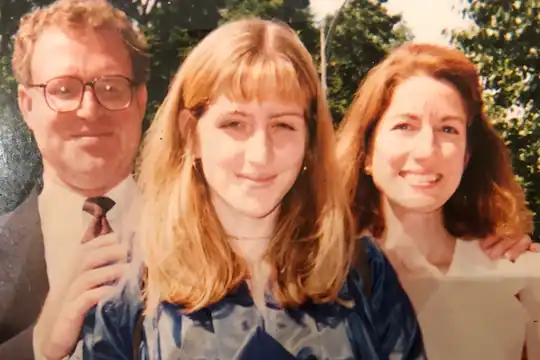When a quiet community is rocked by a brutal murder, a family must wait decades for justice. Who killed Leslie Preer?
Episode Media



Episode Sources
- Obituary for Leslie Jennings Preer
- Death of Chevy Chase Woman Ruled a Homicide
- Services today for murdered woman
- 911 Tape Released in Md. Killing
- Montgomery police form task force for unsolved murders
- Panel Will Review Montgomery Slayings
- Montgomery Panel Calls Six Homicides Unrelated
- Police ask for help solving 2001 murder of woman in Montgomery County
- Montgomery County Police Close 23-Year-Old Cold Case
- Montgomery County Police Department Teams with Othram to Identify the Suspect in 2001 Murder of Leslie Preer
- Murder in Chevy Chase solved after 23 years
- Ex-boyfriend charged in 2001 Chevy Chase mom’s murder after DNA match
- Man arrested in 23-year-old cold case murder of Leslie Preer
- Man arrested in the death of his ex-girlfriend’s mother 23 years ago in Maryland
- Woman’s Ex Charged in 2001 Killing Of Her Mom, Leslie Preer
- Arrest in Chevy Chase cold case murder shocks daughter, neighbors
- Discarded bottle at Dulles helps solve 2001 homicide case, police say
- Additional Details Surrounding the Arrest of Man Accused of Killing His Ex-Girlfriend’s Mother in 23-Year-Old Cold Case
- After 23 years, daughter faces ex-boyfriend in court for mother’s murder
- Eugene Gligor was ‘Zen’ to friends. Now he’s charged with killing his ex’s mom
- How an empty water bottle helped close a 23-year-old Maryland cold case
- She spent years asking who killed her mom. Then her phone rang. How ‘trash’ is helping police catch murder suspects decades later
- Maryland family man who lived in plain sight for nearly 25 years confesses to killing his childhood sweetheart’s mom
- Getting Gligor: How detectives used genetic genealogy to crack open a 23-year-old cold case
- DC man sentenced to 22 years for 2001 murder of his then-girlfriend’s mother
Episode Transcript
Welcome back to Bite-Sized Crime. This week I’m bringing you a case that waited decades for justice, a trail that went cold for so long, there seemed to be no hope. This episode discusses sensitive topics, so listener discretion is advised.
Leslie Ann Jennings was born in October of 1951 in Quonset Point, Rhode Island. One of eight siblings in a military family, Leslie was sensitive and kind, described as being beautiful both inside and out. In 1963, the Jennings family moved to Pensacola, Florida, where Leslie attended Pensacola High School. After graduation, Leslie headed to the University of Florida to study journalism. There, she met a marketing student named Carl Preer – who went by the nickname Sandy – and the two fell in love. They married in 1974, and three years later, they welcomed their daughter Lauren.
In 1982, the Preers moved north, settling in Chevy Chase, Maryland, right on the border of Washington, D.C. Leslie and Sandy both worked while raising their daughter, but they always made time for each other. For two decades, they built a beautiful life in Maryland, the picture of a happy family.
Sadly, on a spring day in 2001, that picture would be shattered.
On the morning of May 2, Sandy Preer received a phone call from Leslie’s boss, Brett. Leslie hadn’t shown up for work, and she wasn’t answering her phone. Concerned, Brett called the numbers for Leslie’s emergency contacts – her husband and daughter – to see if they knew what was going on. But both of them were surprised to hear that Leslie wasn’t in the office. When Sandy had left the house around 7:30 that morning, Leslie had been getting ready for work. She should have left not long after he did, and her bus ride into D.C. should have only taken an hour. Leslie would have called if she was running late, but now it had been several hours with no word from her.
Sandy and Brett both felt that something was amiss. They decided to meet at the house just in case Leslie had been hurt and they needed to get help. When they arrived around 11:30am, the house was quiet. Sandy called out his wife’s name, but there was no response. Then, the men noticed the blood. Streaks of red painted the walls near the front door, and there were dark stains on the floor. A corner table had been knocked over, and the rug that usually lay in the foyer had been dragged into the living room, soaked with blood.
While Sandy moved through the first floor of the house looking for Leslie, Brett called 911. He told the dispatcher, “We just walked in the door, her husband and I, and there’s blood in the foyer. It looks like something possibly happened.” The dispatcher instructed Brett to get out of the house, to wait outside until police came so they wouldn’t contaminate a potential crime scene. Sandy grabbed the family dog, and the men waited in the yard for help to arrive.
Officers from the Montgomery County Police Department arrived at the home on Drummond Avenue a few minutes later. They entered the house and began searching for Leslie, taking in the bloody scene. It wasn’t long before they found what they were looking for. In an upstairs bathroom, lying face-down in the shower, was the body of 49-year-old Leslie Preer. Her legs extended out from the shower doors onto the tile floor of the bathroom; it appeared as if someone had attempted to drag her into the shower and wash the blood from her body.
Investigators with the Forensic Services Section closed off the scene, processing it for fingerprints, fibers, and blood samples. Through chemical analysis, they discovered an area in the foyer where someone had tried to clean up a large amount of blood from the floor and door frame. Blood had been cleaned up from sinks in the kitchen and downstairs bathroom as well as from the trash can and the back door. However, there were no cleaning products found in the home that aligned with what they were seeing. Investigators searched dumpsters at nearby businesses and shopping centers, but they didn’t find anything matching the scene.
Strangely, even with such a violent, bloody scene, Leslie’s death wasn’t treated as a major investigation right away. According to the Washington Post, several important pieces of evidence – including the blood-stained door frames – were not fully processed for several days. Captain Barney Forsythe with the major crimes division told reporters that Leslie’s death didn’t look like an obvious homicide at first, so it wasn’t treated as such until after the autopsy was complete two days later.
When the Chief Medical Examiner’s Office revealed their findings on March 4th, it was clear that Leslie’s death was not an accident: she had been brutally beaten while she fought for her life. There were seven lacerations to her head consistent with the sharp edges of the baseboards in the foyer, indicating that her attacker had repeatedly battered her head against the floor. There were multiple bruises on her arms and torso as well as bruising and hemorrhaging on her neck. The medical examiner ruled her death a homicide, the result of blunt force trauma and strangulation.
With the investigation now in full swing, detectives interviewed everyone in Leslie’s life. Naturally, her husband was the first to be looked at. Sandy Preer told investigators that when he had left the house around 7:30 on Wednesday morning, Leslie had been planning to leave shortly thereafter. A neighbor confirmed that she had seen Sandy leaving that morning. As he walked out the front door, he had called out a goodbye to someone in the house. Another neighbor said she had been outside all morning and hadn’t seen anything unusual. Sandy had been at work until he received the call from Leslie’s boss. It didn’t seem likely that he had killed his wife.
Then, results from the crime lab came back. Blood swabs taken at the scene as well as DNA taken from under Leslie’s fingernails were found to be from an unknown male subject. The DNA was compared to Sandy as well as several other men in Leslie’s life, but all of them were excluded. The profile was uploaded into CODIS – a national DNA database – in the hopes that a match could someday be found.
Meanwhile, investigators widened their net. The town of Chevy Chase had a very low crime rate, but there was always the possibility that a stranger had murdered Leslie. Had someone rung the doorbell and ambushed Leslie when she opened the door? Investigators started looking into recent home invasions and burglaries in the area, but nothing seemed to match.
There was also the possibility that Leslie’s death was connected to other unsolved murders in Montgomery County. Not long after Leslie was killed, the county formed a task force made up of major crimes detectives, forensic investigators, a chemist, and a member of the state attorney’s office. They pored over the files of six unsolved cases, but ultimately, they were unable to find a connection between them.
Months passed, and Leslie’s family struggled with the unanswered questions. Although police had ruled Sandy out as Leslie’s killer, he lived under a cloud of suspicion. Some of Leslie’s relatives believed that he must have done it, but his daughter Lauren stood by his side. She knew her parents had had a loving relationship; Sandy would never have hurt Leslie. He was devastated by her death and mourned her deeply.
Although investigators did everything they could to solve Leslie’s murder, her case eventually went cold. Lauren kept in contact with detectives over the years, but they had little information to offer. Sadly, in 2017, Sandy passed away, never knowing what happened to his wife. Lauren told the Washington Post that she believed her father died of a broken heart.
Then, in 2022, the Montgomery County Police Department announced that their cold case division would be taking a fresh look at Leslie’s case. They asked anyone with information to come forward. Detective Tara Baione told FOX 5, “We have a lot of different angles that we’re looking at, but right now, we’re just reaching out to the public to see if maybe there’s some information out there that maybe someone didn’t want to provide earlier, someone had a change of heart, or 21 years is a long time, there could have been confessions made, or it’s possible that someone wanted to unburden themselves… We’re hopeful that with any information from the community and what we may already have, that we’ll be able to solve this.”
Investigators began re-interviewing the people who knew Leslie, hoping for new leads. They also took another look at the DNA. Back in 2001, the technology was limited, and they had never gotten a hit with CODIS. But two decades later, forensic testing was much more advanced. Investigators reached out to scientists at Othram, a biotech company specializing in forensic genetic genealogy. They submitted blood evidence from Leslie’s crime scene in the hopes that Othram could build a more comprehensive DNA profile and potentially get a name for their unknown male suspect.
Using an open-data DNA database, Othram scientists explored the genetic genealogy of the DNA found in the blood at Leslie’s house. Through that information, they were able to come up with a potential surname: Gligor.
Armed with this information, investigators went back to the case file. On June 4, 2024, Detective Baione came across a tip submitted back in January of 2002. The tipster said that they believed their former neighbor may have had something to do with Leslie’s murder. According to the tipster, the young man was an ex-boyfriend of Leslie’s daughter Lauren. His name was Eugene Gligor.
Detective Baione immediately began searching for Eugene in law enforcement databases. She discovered that he was living in D.C. and had a long history of arrests for weapons possession and theft. However, he had never been arrested for anything that would have required his DNA to be entered into CODIS. Now, they needed to get his DNA to compare it to the profile found at Leslie’s crime scene.
On June 9, 2024, undercover detectives followed Eugene through Dulles International Airport, waiting to make their move. They watched as he drank from a bottle of water and then tossed it into a nearby trash can. After he walked away, detectives collected the bottle and sent it for testing. The DNA from the water bottle was a match to the DNA in Leslie’s case.
On June 18th, 44-year-old Eugene Gligor was arrested and charged with first-degree murder in the death of Leslie Preer.
When Leslie’s family learned of the arrest, they were shocked. Lauren and Eugene had grown up in the same neighborhood and had gone to the same high school. They started dating when Lauren was 15, and Eugene had quickly become a part of her family. He went on trips with them, played board games at their house, and laughed at Sandy’s jokes. Leslie had always been fond of the sweet, gregarious young man who loved her daughter. But Sandy had been more cautious, telling Lauren that something was off about Eugene – he just couldn’t put his finger on it.
None of Eugene’s friends ever saw any signs of violence from him, nothing that would suggest he was capable of the horrific beating of Leslie Preer. But as investigators looked back into Eugene’s past, there were signs of a growing anger inside of him. In high school, he struggled with his parents’ contentious divorce, and harmless teenage mischief soon turned to allegations of theft and substance abuse.
Lauren told the Washington Post about a time a 16-year-old Eugene was accused of assaulting a woman on a bike path. Police thought he matched a description of the suspect, but Lauren didn’t believe it could be true. She recalled going down to the police station with her best friend to speak with detectives. “We both said, there is no way Eugene could have done this.” Decades later, she wondered if it could have been true after all.
Lauren and Eugene dated for five years, but after they went off to college, they drifted apart. Their breakup was amicable, and when they ran into each other in the years after that, there was no tension.
Then, Leslie was murdered. In spite of his closeness to the family, Eugene didn’t attend the funeral, instead choosing to drive across the country to Portland, Oregon, on a last-minute trip. Three months later, he and his mother moved out of the neighborhood.
Over the next two decades, while Lauren mourned her mother, Eugene traveled around the country, marrying and divorcing twice. He struggled with alcoholism and his behavior became increasingly erratic and unpredictable. In 2021, his second wife sought a protective order against him, accusing him of violent outbursts, but her request was ultimately denied. Several friends and co-workers said that there were two sides to Eugene: he could be warm and welcoming, or he could be angry and condescending.
Still, no one ever suspected that he could be capable of murder. In the days after Leslie’s death, Lauren had given his name to detectives as a part of a longer list of people in Leslie’s life. However, there was no indication in the case file that Eugene had been interviewed by investigators, and he had not been swabbed for DNA like the other men on the list. If he had been, Leslie’s murder could have been solved decades earlier, and Sandy would have been alive to see justice served.
After Eugene’s arrest, investigators spent hours questioning him, trying to figure out why he murdered Leslie Preer. He and Lauren had been broken up for three years at that point – he didn’t have any reason to be at her house that day. As far as anyone knew, he didn’t have any hard feelings towards Lauren or her parents, certainly nothing that would explain such a violent attack. Some have theorized that it could have been a robbery gone wrong; perhaps Eugene thought everyone was at work, tried to break in, and was surprised to find Leslie at home. But of course, all of this is speculation. If investigators did find out Eugene’s reason for murdering Leslie, it has never been shared with the public.
As of this recording, Eugene Gligor is being held in the Montgomery County Detention Center while he awaits trial. His next hearing is scheduled for August of 2025.
Lauren told DC News Now that she has found peace knowing that her mother’s killer may be brought to justice. “We have an angel watching over us. She was the best. You’re the best mom in the world, and I’d do anything to have one day with you.”
Leslie Preer was a kind, gentle, intelligent woman who loved her family and her community. She didn’t deserve her terrible fate, didn’t deserve to be brutally murdered by someone she had so generously opened her home to. We can only hope that justice will be served and that her family will finally have the answers they seek.
Case Updates
Updated September 2025 – In May of 2025, Eugene Gligor pleaded guilty to a lesser charge of second-degree murder. At his sentencing, Eugene claimed that he had experienced blackouts due to drug and alcohol use and didn’t remember what happened on that day in 2001. He couldn’t offer the family any explanation. The judge sentenced him to 22 years in prison plus five years of probation. He is currently being held at the Maryland Correctional Training Center in Washington County.
